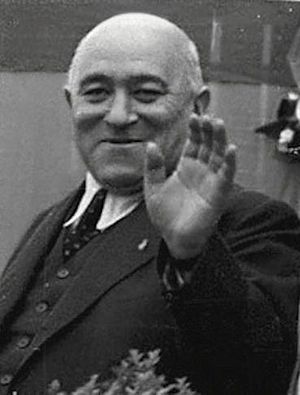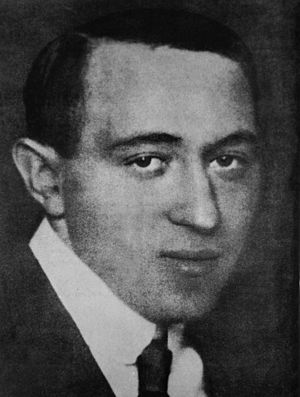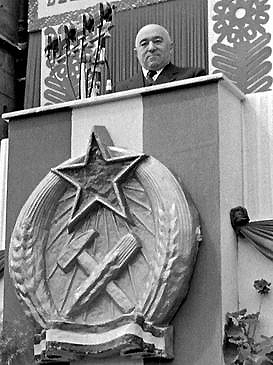Mátyás Rákosi facts for kids
Quick facts for kids
Mátyás Rákosi
|
|||||||||||||||||||||||
|---|---|---|---|---|---|---|---|---|---|---|---|---|---|---|---|---|---|---|---|---|---|---|---|

Rákosi in 1947
|
|||||||||||||||||||||||
| First Secretary of the Hungarian Working People's Party (to 28 June 1953 as General Secretary) |
|||||||||||||||||||||||
| In office 12 June 1948 – 18 July 1956 |
|||||||||||||||||||||||
| Preceded by | Himself as General Secretary of the KMP |
||||||||||||||||||||||
| Succeeded by | Ernő Gerő | ||||||||||||||||||||||
| 43rd Prime Minister of Hungary 2nd Chairman of the Council of Ministers of the People's Republic of Hungary |
|||||||||||||||||||||||
| In office 14 August 1952 – 4 July 1953 |
|||||||||||||||||||||||
| Preceded by | István Dobi | ||||||||||||||||||||||
| Succeeded by | Imre Nagy | ||||||||||||||||||||||
| Acting 14 May 1947 – 31 May 1947 |
|||||||||||||||||||||||
| Preceded by | Ferenc Nagy | ||||||||||||||||||||||
| Succeeded by | Lajos Dinnyés | ||||||||||||||||||||||
| Acting 1 February 1946 – 4 February 1946 |
|||||||||||||||||||||||
| Preceded by | Zoltán Tildy | ||||||||||||||||||||||
| Succeeded by | Ferenc Nagy | ||||||||||||||||||||||
| General Secretary of the Hungarian Communist Party | |||||||||||||||||||||||
| In office 23 February 1945 – 12 June 1948 |
|||||||||||||||||||||||
| Preceded by | Party illegal; various factions | ||||||||||||||||||||||
| Succeeded by | Himself as General Secretary of the MDP |
||||||||||||||||||||||
|
|||||||||||||||||||||||
| Personal details | |||||||||||||||||||||||
| Born |
Mátyás Rosenfeld
9 March 1892 Ada, Austria-Hungary |
||||||||||||||||||||||
| Died | 5 February 1971 (aged 78) Gorky, Russian SFSR, Soviet Union |
||||||||||||||||||||||
| Resting place | Farkasréti Cemetery, Budapest | ||||||||||||||||||||||
| Nationality | Hungarian | ||||||||||||||||||||||
| Political party | MDP | ||||||||||||||||||||||
| Other political affiliations |
MSZDP (1910–1918) MKP (1918–1948) |
||||||||||||||||||||||
| Spouse | Fenia Kornilova (1903–1980) | ||||||||||||||||||||||
| Signature | |||||||||||||||||||||||
| Military service | |||||||||||||||||||||||
| Allegiance | |||||||||||||||||||||||
| Branch/service | |||||||||||||||||||||||
| Years of service | 1914–1915 1919 |
||||||||||||||||||||||
| Rank | Commander of the Red Guard | ||||||||||||||||||||||
| Battles/wars | World War I Revolutions and interventions in Hungary (1918–20) | ||||||||||||||||||||||
Mátyás Rákosi (born Mátyás Rosenfeld; 9 March 1892 – 5 February 1971) was a Hungarian communist politician. He was the main leader of Hungary from 1947 to 1956. He first served as General Secretary of the Hungarian Communist Party from 1945 to 1948. Then he became General Secretary (later called First Secretary) of the Hungarian Working People's Party from 1948 to 1956.
Rákosi was involved in left-wing politics from a young age. In 1919, he was a key leader in the short-lived Hungarian Soviet Republic. After this government fell, he left Hungary. He worked abroad as an agent for the Comintern, an international communist organization. He was arrested in 1924 when he tried to return to Hungary. He wanted to organize the Communist Party secretly. He spent over fifteen years in prison.
He became a famous figure in the international Communist movement. A group of Hungarian fighters in the Spanish Civil War was even named the Rákosi Battalion after him. Rákosi was finally allowed to go to the Soviet Union in 1940. This was part of an exchange for old battle flags captured by Russian forces in 1849.
When the Red Army pushed German forces out of Hungary in 1945, Rákosi came back home. He became the leader of the re-established Hungarian Communist Party. The Party lost badly in Hungary's free election in 1945. However, the Soviet Union insisted that Communists get important government jobs. Rákosi himself became a very powerful deputy prime minister.
From this position, the Communists used clever tactics to weaken their opponents. Rákosi later called this "salami tactics". This meant removing opponents bit by bit, like slicing a salami. By 1948, they had full control of the country. In 1949, Hungary became a "people's republic" with Rákosi as its absolute ruler.
Rákosi strongly supported Stalin and the Soviet Union. He even created a "personality cult" around himself, just like Stalin did. During his rule, many Hungarian people were arrested or faced harsh punishments. He organized "show trials", which were unfair trials like those in the USSR. One famous victim was his former assistant, László Rajk. His policies, like forcing farmers to join collective farms and strict control, harmed the country's economy and political life. This caused a lot of unhappiness.
After Stalin died in 1953, Rákosi lost some power. The Soviet Union wanted the reform-minded Communist Imre Nagy to become the new Prime Minister. But Rákosi still had influence as First Secretary. He used this power to stop Nagy's attempts at reform. He eventually forced Nagy out of office in 1955.
However, in 1956, Soviet leader Nikita Khrushchev gave a famous "Secret Speech". He spoke out against Stalin's crimes. This made Rákosi's position very weak. Many people in the Party and across Hungary started to speak against him. They called for him to resign as more information about the Party's past actions came out. Rákosi was finally forced to resign in July 1956 and leave for the Soviet Union. He was replaced by his second-in-command, Ernő Gerő.
The Hungarian Revolution of 1956 happened just three months later. It was a result of the problems caused by Rákosi's system. His former rival, Imre Nagy, became an important figure in the Revolution. Soviet troops eventually stopped the uprising. They put a new Communist government in place, led by János Kádár.
Rákosi lived the rest of his life in the Soviet Union. The Hungarian government did not let him return home. They feared it would cause public unrest. He died in Gorky in 1971. His ashes were secretly returned to Hungary for burial. Today, Rákosi is often seen as a symbol of harsh rule and control in Hungary.
Contents
Early Life and Education
Mátyás Rákosi was born in Ada, a village in what was then the Kingdom of Hungary. Today, Ada is a town in Vojvodina, Serbia. He was born to Jewish parents. His father, József Rosenfeld, was a grocer. His family later changed their last name to Rákosi in 1903. Rákosi later said he did not follow any religion, like many other Marxists.
Rákosi was a good student. He finished elementary school in Sopron. He then completed his final exams at a high school in Szeged in 1910. He went on to study international trade. He received scholarships to study for a year in Hamburg (1912) and another year in London (1913).
While still a student in Hungary, he joined the Hungarian Social Democratic Party (MSZDP) in 1910. He was also active in a student group called the Galileo Circle.
During World War I, he served in the Austro-Hungarian Army. In 1915, he was captured on the Eastern Front and became a prisoner of war in Russia. He managed to escape and went to Petrograd, which was a center of the Russian Revolution.
Starting His Political Career
After returning to Hungary, Rákosi joined the communist movement led by Béla Kun. He also became a member of the Hungarian Communist Party. When the Hungarian Soviet Republic was formed in 1919, Rákosi served as a Deputy People's Commissar for Trade. He also helped lead social production. He was involved in military campaigns against Czechoslovakia and Romania. For a short time, he was even the Commander of the Red Guard, which was an internal police force.
After the Soviet Republic fell, Rákosi left Hungary in August 1919. He went to the Soviet Union. There, he worked for the Communist International, also known as Comintern. He returned to Hungary in 1924 and was put in prison. However, in 1940, he was released and sent back to the Soviet Union. This was part of a prisoner exchange. In the Soviet Union, he became a leader in the Comintern. In 1942, he married Fenia Kornilova. He returned to Hungary in January 1945. Soviet authorities chose him to organize the Hungarian Communist Party.
Becoming Hungary's Leader
When the Red Army helped set up a Soviet-approved government in Hungary (1944–1945), Rákosi was made General Secretary of the Hungarian Communist Party (MKP). He was also a deputy prime minister from 1945 to 1949.
At first, Rákosi and the Communists seemed willing to work with other political parties. But from 1947 onwards, they started to pressure other parties. They wanted to remove anyone who disagreed with them, calling them "fascists". Once the Communists gained full control, Rákosi reportedly described this method as "salami tactics". He meant he had removed non-Communist groups by cutting them off one by one.
This process began when Prime Minister Ferenc Nagy was forced to resign. He was replaced by a more cooperative leader. By the 1947 elections, the Communists had won the most votes. They had also greatly weakened the next largest non-Communist party, the Social Democrats.
By late 1947, Rákosi stopped pretending to support democracy. He told the non-Communist parties they had to work with a new government led by Communists. Otherwise, they would have to leave the country. By the end of 1947, most opposition parties had removed their strong-willed members. This left them with people who would follow the Communists' orders. In 1948, the Communists forced the Social Democrats to join them. They formed the Hungarian Working People's Party (MDP). However, any Social Democrats who still thought independently were quickly removed. This made the MDP simply a larger, renamed Communist Party.
Rákosi also forced the president, Zoltán Tildy, out of office. He replaced him with a Social Democrat who had become a Communist. A year later, elections were held with only one list of candidates. Even though some non-Communists were on the list, they were actually supporters of the Communist Party.
Rákosi called himself "Stalin's best Hungarian student". He created a strong "cult of personality" around himself. This meant he was praised and admired like a hero.
Many officials and thinkers were removed from their jobs under his rule. Rákosi created a very strict government in Hungary. He arrested, jailed, and punished many people he saw as enemies. In August 1952, he also became Prime Minister.
However, in June 1953, Rákosi and other party leaders were called to Moscow. Soviet leaders criticized Hungary's poor economic performance. To please the Soviet leaders, Rákosi agreed to share power. He gave up the role of Prime Minister to Imre Nagy. But he kept his position as General Secretary. Nagy wanted a kinder way of governing, which Rákosi strongly opposed. In March 1955, Nagy was criticized by the Party. Hungarian newspapers blamed Nagy for the country's economic problems. In April, Nagy was removed from his post. Rákosi and Nagy's replacement, András Hegedüs, quickly brought the country back to its strict, Stalin-like policies.
Economic Challenges Under Rákosi
After World War II, Hungary's economy faced many problems. A major issue was the damage to buildings and roads during the war. About 40% of the country's wealth was destroyed. This included all bridges, railways, and factories. Hungary also had to pay about $300 million in war reparations to the Soviet Union and other countries. They also had to support Soviet soldiers stationed in Hungary.
In 1946, a new, stable currency was introduced. This helped after a period of very high inflation. However, there were often shortages of goods, especially in the countryside. This made people unhappy. Also, huge amounts of money were spent on the military after the Korean War started. This meant even fewer goods were available for people to buy. Because of these shortages, people were forced to save money by buying state bonds. Wages also did not increase enough to keep up with prices.
End of His Rule

Rákosi was removed as General Secretary of the Party in June 1956. This happened because of pressure from the Soviet Union, shortly after Nikita Khrushchev's "Secret Speech". He was replaced by Ernő Gerő.
To get him out of Hungarian politics, the Soviet Union sent Rákosi into exile in 1956. The official reason was that he needed "medical attention". He lived in different towns in the Soviet Union.
In 1970, Rákosi was finally allowed to return to Hungary. But he had to promise not to get involved in politics. He refused this offer and stayed in the USSR. He died in Gorky in 1971. After his death, his ashes were secretly brought back to Hungary. He was buried in the Farkasréti Cemetery in Budapest. Only his initials are on his gravestone to prevent damage.
See also
 In Spanish: Mátyás Rákosi para niños
In Spanish: Mátyás Rákosi para niños




